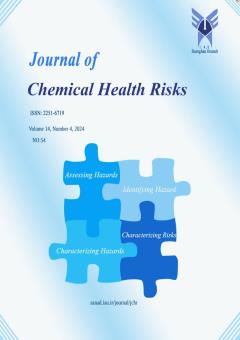Ethanolic Extract of Vitis vinifera (Black grapes) Skin as a Safer Alternative to Hematoxylin and Eosin stain
Subject Areas : Journal of Chemical Health Risks
Rahul Mohandas
1
![]() ,
Subhashree Mohapatra
2
*
,
Subhashree Mohapatra
2
*
![]()
1 - Department of Oral and Maxillofacial Pathology and Oral Microbiology, Dr. D.Y. Patil Dental College and Hospital, Dr. D.Y. Patil Vidyapeeth, Pune, India
2 - Department of Public Health Dentistry, Dr. D.Y. Patil Dental College and Hospital, Dr. D.Y. Patil Vidyapeeth, Pune, India
Keywords: Black grapes, Cytoplasmic stain, Hematoxylin and Eosin, Histopathology, Nuclear stain, Organic stains, Vitis vinifera,
Abstract :
Hematoxylin and eosin (H&E) is the gold standard stain in routine histopathological staining. However, the worldwide shortage of hematoxylin, the substandard quality of the stain, its infrequent supply, and increasing cost have troubled pathologists across the globe. Besides, the treatment with acidic solutions in trichrome and other stains leads to diminished nuclear staining. This combined with the detrimental effects of eosin, which is a synthetic dye, has encouraged the development of newer, eco-friendly, organic dyes from natural derivates. The present study aimed to evaluate the staining efficacy of ethanolic extract of Vitis vinifera (Black grapes) skin in routine histopathological staining compared to H&E stain. Dye components from Vitis vinifera skin were extracted using absolute ethanol. The ethanolic extract of Vitis vinifera skin and H&E stain were used to stain tissue blocks containing mucosa, muscle, gland, lymph nodes, and decalcified bone. The slides were evaluated for the nuclear details, nuclear staining, cytoplasmic staining, and uniformity by a blinded pathologist. A chi-square test was done to check the statistical significance. Ethanolic extract of Vitis vinifera skin demonstrated nuclear details comparable to H&E. However, the difference in staining between the stains was not found to be statistically significant (p=0.088). This study showed that dye components can be extracted from Vitis vinifera skin. The nuclear staining of histological tissue with ethanolic extract of Vitis vinifera skin was comparable to the H&E stain.
1. Culling C.F.A., 2013. Handbook of Histopathological and Histochemical Techniques: Including Museum Techniques. 3rd edition. Butterworth-Heinemann.
2. Chan J.K.C., 2014. The Wonderful Colors of the Hematoxylin–Eosin Stain in Diagnostic Surgical Pathology. International Journal of Surgical Pathology. 22(1), 12–32.
3. Avwioro G., 2011. Histochemical uses of Haematoxylin- A review. JPCS. 1, 24–34.
4. Dapson R., Horobin R. W., Kiernan J., 2010. Hematoxylin shortages: their causes and duration, and other dyes that can replace hemalum in routine hematoxylin and eosin staining. Biotechnic & Histochemistry: Official Publication of the Biological Stain Commission. 85(1), 55–63.
5. Ebrahimi M., Parham A., 2020. Using Herbal dyes as an alternative staining method for sperm evaluation. Veterinary Medicine and Science. 6(3), 441–446.
6. Sun Y., Ong K., 2004. Material Safety Data Sheet. In Detection Technologies for Chemical Warfare Agents and Toxic Vapors, CRC Press. 231-239.
7. Wittekind D., 2003. Traditional staining for routine diagnostic pathology including the role of tannic acid. 1. Value and limitations of the hematoxylin-eosin stain. Biotechnic & Histochemistry: Official Publication of the Biological Stain Commission. 78(5), 261–270.
8. Suvarna K. S., Layton C., Bancroft J. D., 2018. Bancroft’s Theory and Practice of Histological Techniques E-Book. Elsevier Health Sciences.
9. Titford M., 2005. The long history of hematoxylin. Biotechnic & Histochemistry. 73–78.
10. Afzalzadeh M. R., Ahangarpour A., Amirzargar A., Varnamkhasti M. K., Ganjalidarani H., 2015. The Effect of Vitis vinifera L. Juice on Serum Levels of Inhibin B, Sperm Count in Adult Male Rats. The World Journal of Men’s Health. 109.
11. Nassiri-Asl M., Hosseinzadeh H., 2016. Review of the Pharmacological Effects of Vitis vinifera (Grape) and its Bioactive Constituents: An Update. Phytotherapy Research: PTR. 30(9), 1392–1403.
12. Fang J., Jogaiah S., Guan L., Sun X., Abdelrahman M., 2018. Coloring biology in grape skin: a prospective strategy for molecular farming. Physiologia Plantarum. 164(4), 429–441.
13. Bechtold T., Mahmud-Ali A., Mussak R., 2007. Anthocyanin dyes extracted from grape pomace for the purpose of textile dyeing. Journal of the Science of Food and Agriculture. 2589–2595.
14. Bridle P., Timberlake C. F., 1997. Anthocyanins as natural food colours—selected aspects. Food Chemistry. 58(1), 103–109.
15. Howard L. R., Clark J. R., Brownmiller C., 2003. Antioxidant capacity and phenolic content in blueberries as affected by genotype and growing season. Journal of the Science of Food and Agriculture. 1238–1247.
16. Bechtold T., Mussak R., Mahmud-Ali A., Ganglberger E., Geissler S., 2006. Extraction of natural dyes for textile dyeing from coloured plant wastes released from the food and beverage industry. Journal of the Science of Food and Agriculture. 233–242.
17. Wulf L.W., Nagel C.W., 1978. High-Pressure Liquid Chromatographic Separation of Anthocyanins of Vitis Vinifera. American Journal of Enology and Viticulture. 29(1), 42–49.
18. Dangles O., Fenger J.A., 2018. The Chemical Reactivity of Anthocyanins and Its Consequences in Food Science and Nutrition. Molecules. 23(8), 1970.
19. Phan K., Raes K., Van Speybroeck V., Roosen M., De Clerck K., De Meester S., 2021. Non-food applications of natural dyes extracted from agro-food residues: A critical review. Journal of Cleaner Production. 301, 126920.
20. Kiernan J.A., 2008. Nuclear stains. Cold Spring Harbour Protocols. 3(7). doi:10.1101/pdb.top50 Cold Spring Harb Protoc 2008.

